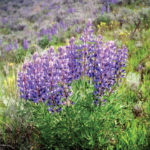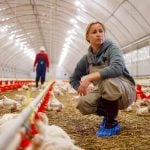
Grazing

Plan for drought to minimize the effect on your herd
News Roundup from the May 2023 issue of Canadian Cattlemen
Anyone farming and ranching in the Great Plains is going to have to deal with drought, so it’s best to be as prepared as possible. That was the message from Anneliese Walker at the Canadian Forage and Grasslands Association conference last fall. Walker is a Princeton, Minnesota producer who also works for Maia Grazing, which […] Read more

Pond scum: blue-green algae and cattle
It’s a routine summer day of checking cattle, maybe repairing a bit of fence. Nothing too stressful, at least until you see the dugout you’re using as a water source for your cattle, which has algae in it. Now what? The first question is whether it’s blue-green algae, which can release toxins harmful to cattle, […] Read more

AUDIO: Spring droughts – and floods – favour toxic plants
At the end of April, the government of Canada’s Canadian Drought Outlook had listed most areas in the Prairies as experiencing abnormally dry conditions, or moderate to extreme drought conditions. By the end of May, this had changed, with the drought lifting or improving in many areas of Saskatchewan. The Weather Network predicts areas in […] Read more

Stocking cattle and stockpiling forage
Tim Wray walks us through his family’s plan for the grazing season as they seek to balance forage supplies with cattle inventory
When it comes to handling drought, a little planning and strategy go a long way for the Wray family. Tim Wray grew up on his family’s cattle operation in Irricana, a small town located 50 kilometres northeast of Calgary. Today Tim and his uncle, Doug Wray, operate Wray Ranch, which has endured dry conditions for […] Read more

Lupines and crooked calves
If you’ve seen birth defects such as fused joints, crooked legs or cleft palates in your newborn calves, toxic plants could be the culprits
Lupine calves” or “crooked calves” are an example of what can happen when various plant toxins are ingested by a pregnant cow at a certain stage of pregnancy. Lupines, also known as bluebonnets, are legumes. As legumes, they can enrich nitrogen-poor soil. In Canada, at least 28 species have been recognized, mostly in Western Canada. […] Read more

Do you have a drought management strategy?
With more droughts in the future, grass managers need to develop a strong management plan and a destocking strategy to act upon when it doesn’t rain or have a method to take advantage of lush growth if there’s plenty of moisture. “The stock or destock strategy is an interesting and difficult concept,” says Dr. Bart […] Read more

Grazing management and soil health, Part 2
A look at how to apply adaptive multi-paddock grazing to different, and constantly changing, contexts
In part 1 of this topic, we discussed how following the six principles of soil health can improve the four ecosystem functions or processes which will also improve your soil and its productivity. Now let’s graze. There have been many names given to grazing methods. Some even argue about the use of names and if […] Read more

Grazing management and soil health
By adapting grazing practices that fit your context and by following the six soil health principles, you can improve the soil on your ranch
I hope this title suggests that there is a definite causal link between grazing management and soil health. Nothing you do on grazing lands can improve soil health more than good grazing management. While growing up, I wanted to be a rancher because I liked cattle and the challenge of raising them profitably. I wanted […] Read more

Beware of toxic plants in pastures
There are many toxic plants in Western Canada cattle producers need to steer clear of
Different regions have different problem plants, and to make it even more confusing these same plants are only toxic if eaten in certain amounts or in certain stages of growth, while others are toxic at all times. Rachel Turnquist, a forage extension specialist in Saskatchewan, says there are many toxic plants in Western Canada. You […] Read more



